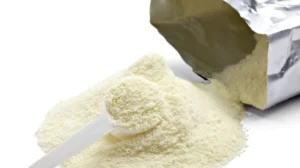Powdered milk: Powdered milk, also known as dry milk or milk powder, is a convenient and long-lasting alternative to fresh milk. It has a wide range of applications, from being an ingredient in various recipes to serving as a source of nutrition in emergency situations. However, like any other food product, powdered milk has its downsides. In this article, we’ll explore nine potential dangers of consuming powdered milk.

Nutritional Deficiencies: Powdered milk
One of the primary concerns with powdered milk is that it lacks some of the essential nutrients found in fresh milk. During the manufacturing process, certain vitamins and minerals may be lost, making it less nutritious. While powdered milk is often fortified with some vitamins and minerals, it may not provide the same level of nutrition as fresh milk.
Oxidation and Rancidity
Powdered milk is susceptible to oxidation and rancidity, which can occur due to exposure to light, heat, or moisture. When powdered milk oxidizes, it can develop an unpleasant taste and odor. To avoid this, it’s crucial to store powdered milk in a cool, dry, and airtight container.
Digestive Issues: Powdered milk
Some individuals may experience digestive discomfort after consuming powdered milk. This could be due to lactose intolerance or a sensitivity to the proteins found in milk. While some varieties of powdered milk are lactose-free, others may still contain lactose, leading to digestive problems in sensitive individuals.
Unwanted Additives
Many commercial powdered milk products contain additives such as preservatives, emulsifiers, and stabilizers. These additives are used to improve the texture and shelf life of the product. While most of these additives are generally recognized as safe (GRAS) by regulatory agencies, some people prefer to avoid consuming them.
Risk of Contaminants: Powdered milk
Powdered milk can be susceptible to contamination with bacteria, molds, or other microorganisms if not stored properly. This can lead to foodborne illnesses and spoilage. It’s essential to follow proper storage guidelines and use powdered milk within its recommended shelf life to reduce the risk of contamination.
Texture and Flavor Differences
The taste and texture of powdered milk can differ significantly from fresh milk. Some individuals find the flavor of powdered milk to be less appealing, describing it as having a slightly “off” taste compared to fresh milk. The reconstitution process can also affect the texture and consistency of the final product.
Reduced Bioavailability: Powdered milk
Certain nutrients in powdered milk may not be as readily absorbed by the body as those in fresh milk. This reduced bioavailability can impact the overall nutritional value of the milk. For example, the calcium in powdered milk may not be as efficiently absorbed as calcium from fresh milk.
Potential for Overconsumption
Because powdered milk is in a concentrated form, there’s a risk of overconsumption if it’s not properly measured or reconstituted. Consuming too much powdered milk can lead to an excessive intake of calories, fat, and other nutrients, which can have negative health consequences.
Environmental Concerns: Powdered milk
The production of powdered milk involves significant energy consumption and contributes to greenhouse gas emissions. Additionally, the packaging of powdered milk often generates plastic waste. Choosing more sustainable alternatives, such as fresh milk or plant-based milk alternatives, may be a more environmentally friendly choice.
While powdered milk can be a convenient and versatile food product, it’s essential to be aware of its potential dangers. These include reduced nutritional value, susceptibility to oxidation and contamination, digestive issues for some individuals, and the presence of additives. To make an informed choice, consumers should weigh the benefits and drawbacks of powdered milk and consider their dietary preferences and nutritional needs. Additionally, it’s crucial to follow proper storage and preparation guidelines to minimize the risks associated with powdered milk consumption.